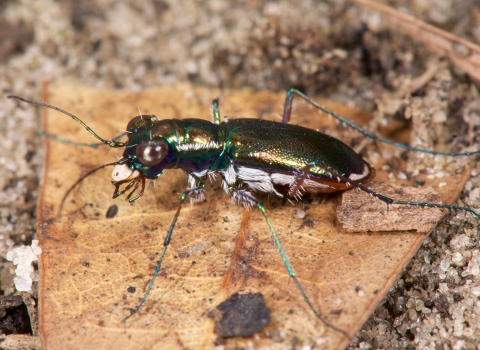GAINESVILLE, Fla. - The U.S. Fish and Wildlife Service is designating approximately 1,869 acres as critical habitat in Miami-Dade County, Florida, for the endangered Miami tiger beetle. The tiny iridescent green Miami tiger beetle is one of the smallest tiger beetles in the U.S. and is only found in the imperiled pine rocklands ecosystem in south Florida.
The beetle’s small habitat range is threatened by development, encroaching vegetation, and the environmental impacts of climate change climate change
Climate change includes both global warming driven by human-induced emissions of greenhouse gases and the resulting large-scale shifts in weather patterns. Though there have been previous periods of climatic change, since the mid-20th century humans have had an unprecedented impact on Earth's climate system and caused change on a global scale.
Learn more about climate change . An estimated 98% of the historical pine rocklands within Miami-Dade County outside of Everglades National Park is gone and this habitat loss is expected to continue.
“Designating critical habitat is crucial to ensuring the continued survival of this rare and endangered beetle,” said acting Southeast Regional Director Mike Oetker. “We appreciate the information and support from our partners and the public that guided us in developing this final rule.”
The critical habitat designated for the Miami tiger beetle includes 1,464 acres of occupied habitat and 405 acres of unoccupied habitat. The Service deemed it necessary to designate unoccupied areas to protect the remaining two small, isolated populations from encroaching habitat loss. The unoccupied units are within the tiger beetle’s historical range and contain suitable habitat, and the physical and biological features essential to the conservation of this species.
Most of the critical habitat designated for the Miami tiger beetle is under federal (26%), state (12%), and county (60%) ownership. Approximately 71% of this designated critical habitat overlaps lands already designated as critical habitat for several other federally protected species – Carter's small-flowered flax, the Florida brickell-bush, Bartram’s scrub-hairstreak butterfly, and the Florida leafwing butterfly.
When a species is listed under the Endangered Species Act, the Service must identify areas essential to its conservation, known as critical habitat. This designation requires federal agencies to ensure that actions they plan to undertake, fund, or authorize do not destroy or adversely modify that habitat. It does not establish a wildlife refuge, allow the government or public to access private lands, or require non-federal landowners to restore habitat or recover species.
This final rule takes effect 30 days from publication in the Federal Register. The Service listed the Miami tiger beetle as an endangered species under the ESA in October 2016, published the proposed rule to designate critical habitat in September 2021, extended the comment period to 45 days, and held a public hearing in December 2021. The final designation was developed from the additional comments and information from the comment period and public hearing.
The final rule, comments, supporting documentation, and the economic analysis are available at https://www.regulations.gov, Docket No. FWS-R4-ES-2021-0053. Coordinates for the final critical habitat can be found here: https://www.fws.gov/office/florida-ecological-services/library
Learn more in our Frequently Asked Questions.




